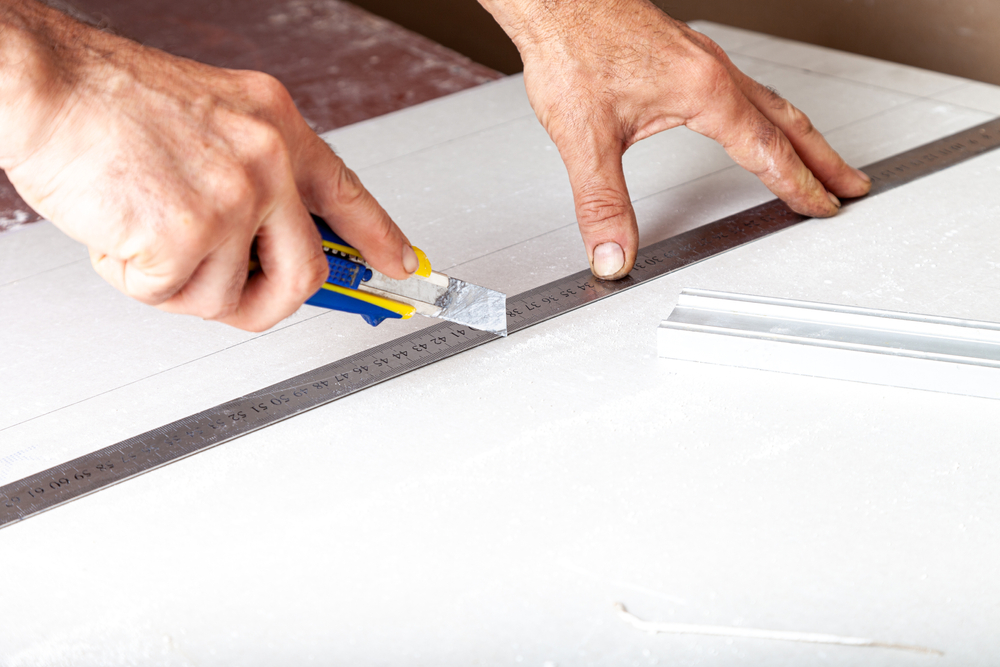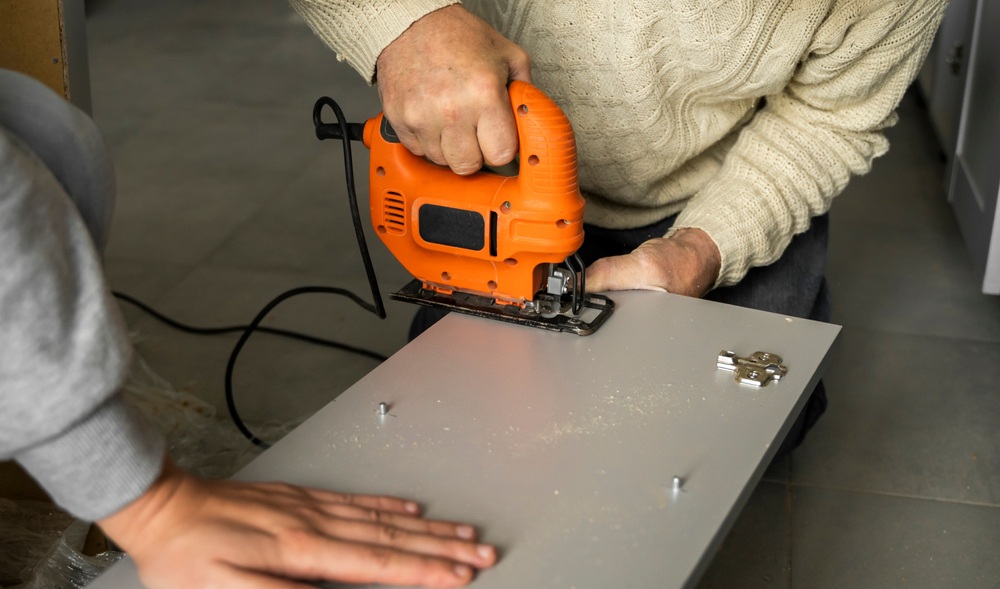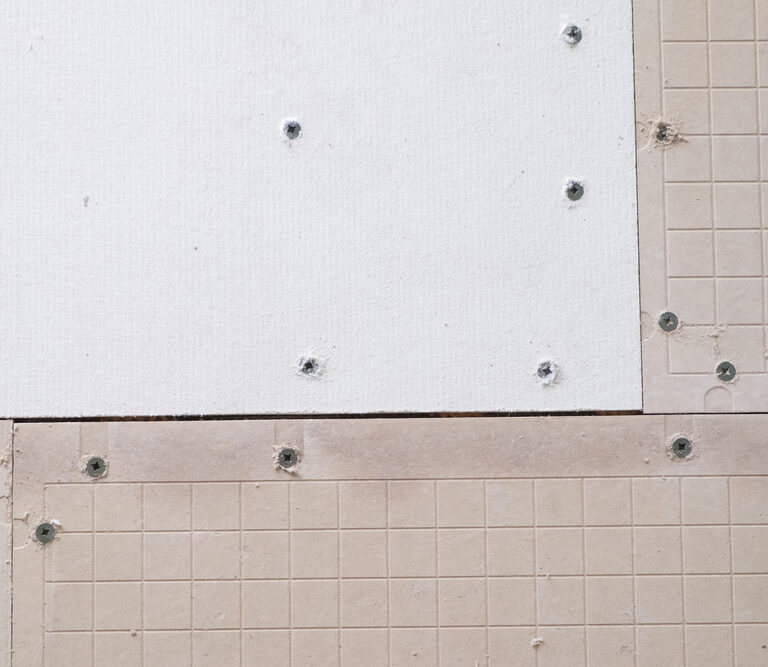If you’re a DIY enthusiast, you’ll probably use cement backer board for a project at some point. Whether you’re laying flooring or tiling your walls, cement board has a vital role to play. Although cement board is a great construction solution, its cement construction and strength are a downside when it comes to cutting. Fortunately, if you’re equipped with the correct tools, the right techniques and some patience, it’s perfectly possible to cut through this strong and sturdy material.
What Is Cement Backer Board and What Is It Used For?
It’s easy to see why cement backer board is so popular with fans of do-it-yourself. It can create a substrate that is far harder and flatter than plywood which may rot, sag or warp. Cement board is also stronger than plywood. This makes it a more durable, reliable construction material than wood.
Since it offers so many benefits, it isn’t too surprising that construction professionals use cement board on virtually all jobs, including countertops, floors and walls. Cement board also makes it especially easy to lay tiles. This is because, instead of having to set the tiles in a thick mortar bed, backer board allows you to use only thin-set mortar which makes the installation considerably simpler.
There are two kinds of cement backer board available. Both are primarily made from Portland cement. While one kind of heavy and hard (very like concrete), the other is lighter, more fibrous and softer. There are also four thicknesses of cement board available – from ¼” up to 5/8” thick – but only two different sizes (3×5 feet and 4×8 feet). This means that, for many projects, DIYers need to cut the cement backer board to the correct shape and size in order to complete the task in hand. This is where problems begin to arise!
Cutting Cement Backer Board: Several Different Methods

Here, we’ll show you how to cut cement board efficiently and easily using several different methods, so that you can get started on your next home improvement project.
Scoring and Snapping Thinner Sheets
If you’re looking for the easiest way to cut your cement board, scoring and snapping it is the simplest solution of all.
Step 1.
First, decide which of the cement board’s sides is the side you will have facing upwards when the board is installed.
Step 2.
Lay the cement board down flat on a workstation, sawhorse, or on the ground.
Step 3.
Using a carpenter’s pencil, draw a line where you’re going to cut using a ruler. Take care to make the line visible and straight. Then carefully place something with a straight edge along the line you’ve drawn.
Step 4.
Drag a scoring tool or drywall utility knife along it, taking care to ensure the board is stable and flat. Use your ruler and apply pressure as you drag the knife along the marked line.
Step 5.
Repeat these cuts two or three times. Each time, apply a little more pressure, so the cuts become deeper. When the cut has penetrating halfway through the cement board, stand it upright.
Step 6.
Put your knee against the back of the cement board at a level with the cuts you’ve made. Using your knee’s weight to apply pressure while holding the board. This will split the board along the scored lines.
Step 7.
Use your utility knife to cut the connecting inner mesh apart. Take care not to drop the board since it could crack or chip. While cutting, make sure you cut away from your body for your own safety.
Note:
Bear in mind that cement board must be no thicker than ½” thick to be cut in this way. If it is any thicker, a saw will need to be used for cutting it.
Cutting With a Circular Saw

If you’re looking for a way to make more efficient, smooth cuts in your cement board, power tools are the answer. Using a circular saw will speed the cutting process exponentially.
While circular saws are typically used for cutting wood, they’re also capable of making clean, quick cuts in cement backing board. You should fit the saw with a wood-cutting carbide-tipped blade. The blade should have as few teeth as possible, as this will reduce dust production while you’re sawing.
Carbide-tipped blades are capable of withstanding the difficult task of cutting through cement, but bear in mind that if you breathe in concrete dust or allow it to get in your eyes it can be hazardous to your health. You should also use breathing and eye protection when sawing cement boards.
Step 1.
Using your carpenter’s pencil and a ruler, mark a line on the board where you need to cut. Make sure the line is visible and straight. Remember you’ll cut along the back of the cement board, so mark the underside.
Step 2.
Set the blade’s depth so that it extends ½” below the cement board. Make sure you have secured the blade in position.
Step 3.
Place the board down on your sawhorse with its back facing upwards. Align the line that you drew on the board with the cutting guide. Take care to secure the board so it doesn’t move or shake.
Step 4.
You need to ensure the saw’s blade is rotating at its full speed before making contact with the cement board. Carefully, guide the saw’s blade through the marked line. Push smoothly and slowly, but not too hard, as otherwise the saw’s blade could get jammed in the board.
Using Power Tools to Cut Circles in Cement Board

Sometimes, you’ll need to cut circular holes in cement board for piping or wiring. In these cases, you can either use a masonry bit fitted on an electric drill or a jigsaw.
To use a drill and bit, simply mark the area you need to cut on the board using a carpenter’s pencil, then carefully drill the bit into the board. By using some pressure, the board will be cut through.
Using a power scroll saw (otherwise known as a jigsaw) to make round cuts in cement board is the most effective solution, since it is designed for cutting irregular shapes. Similar in appearance to a bandsaw, a jigsaw is shorter and makes cuts using an up-and-down movement. Jigsaws can make round or straight cuts.
To use a jigsaw to cut cement board, follow these instructions:
Step 1.
First, fit your jigsaw with a carbide-grit or metal-cutting blade. Since cement is difficult to cut through you’ll need to choose the correct blade to get the job done. Secure the blade firmly into the saw.
Step 2.
Put the board down on the sawhorse facing upwards. This will enable you to mark the board’s surface and see where you need to make the cuts in order to avoid cracking and chipping. Ensure the board is stable and secure on the sawhorse.
Step 3.
Use a carpenter’s pencil to mark where the cuts need to be made on the board’s surface. When you use a jigsaw, you’ll need to follow a guide when cutting irregular or round shapes. Marking the board will ensure you can customize your cuts, as required. Use a round object or a stencil to ensure the line you’re marking is even and accurate.
Step 4.
You will need to create an opening through which the jigsaw can fit into the board. You can create one by using a masonry bit fitted to a drill. Drill a hole into the cement board so that the jigsaw’s blade can fit into it.
Step 5.
If the shape that you’re planning to cut has turns and twists, you should drill a hole through the cement board at all of the shape’s tightest corners. This will facilitate the turning of the jigsaw’s blade when it reaches those turns. If the jigsaw’s blade cannot take the turns with ease, the blade could bend or, even worse, break, and this could cause you to be injured.
Step 6.
Insert the jigsaw’s blade into the hole drilled through the cement board.
Step 7.
Switch the saw on and allow it to reach full speed. If it isn’t moving at full speed when making contact with the board it may catch and this could cause it to bend or break, potentially causing damage to the saw or harming you.
Step 8.
Apply a little pressure to prevent the saw from bouncing off the board as you slowly push it through the board, cutting it.
Step 9.
Closely follow the guide markings that you’ve made, slowing down when taking any turns. If you feel or hear the blade stalling or catching in the board, slow the speed down. Back up and let the blade return to full speed before continuing to push the saw’s blade through the cement board.
Completing Your Cutting Project
Cement board is a versatile construction solution, especially if you’re carrying out flooring or tiling in your home. If you follow the instructions outlined here, you should find that it’s easier than you imagined to cut it to the shape and size you require.
